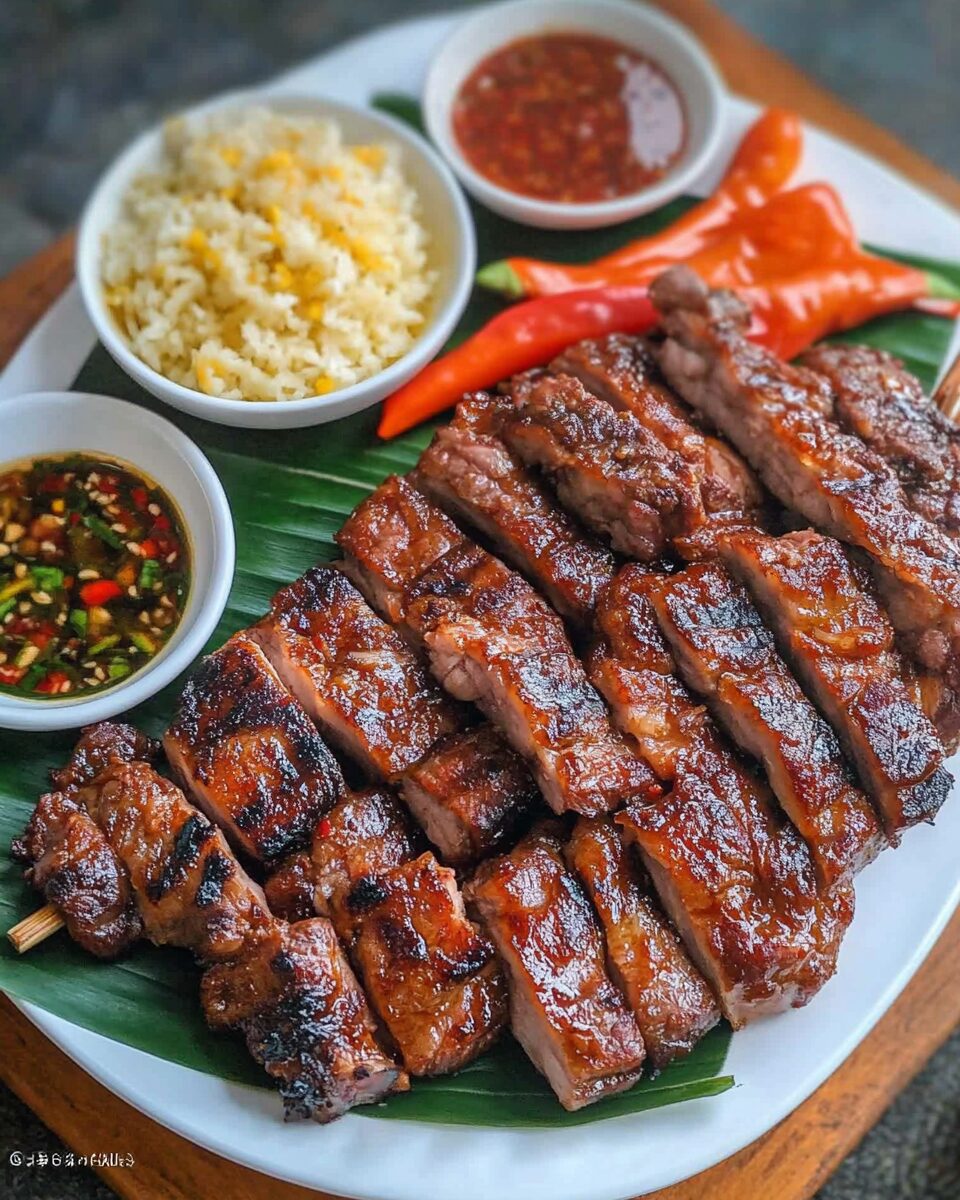Filipino Style Pork BBQ is a beloved street food and party staple in the Philippines. Each skewer is made with thinly sliced pork shoulder marinated in a mouthwatering mixture of soy sauce, banana ketchup, calamansi, garlic powder, and a touch of sweetness from brown sugar and soda. Grilled to caramelized perfection over hot charcoal, this dish captures the perfect balance of sweet, salty, and smoky.
What makes this dish so special is its versatility and nostalgic value—it’s a go-to for birthdays, fiestas, or simple family dinners. Served best with spicy vinegar for dipping and warm Java rice, Filipino Pork BBQ is the ultimate comfort food that brings the flavors of the Philippines right to your plate. Whether you’re sharing with friends or savoring it solo, this recipe never fails to deliver bold, unforgettable flavor.
Full recipe:
Ingredients:
-
4 lbs. pork shoulder, sliced into thin strips
-
¾ cup soy sauce
-
½ cup calamansi or lemon juice
-
¾ cup banana ketchup
-
4 tablespoons dark brown sugar
-
2 tablespoons garlic powder
-
1 teaspoon ground black pepper
-
2 teaspoons salt
-
1 ½ cups lemon or lime soda
(Optional for serving: spicy vinegar dip)
Directions:
-
In a large mixing bowl, combine all the marinade ingredients and stir until well blended.
-
Add the sliced pork into the marinade. Mix thoroughly so that each piece is coated.
-
Cover the bowl with cling wrap and marinate in the refrigerator for at least 3 hours or overnight for best flavor.
-
Thread the marinated pork slices onto bamboo skewers.
-
Prepare your grill (preferably charcoal for authentic flavor) and preheat to medium-high heat.
-
Grill the skewers for 3–5 minutes on each side, basting occasionally with the leftover marinade (without the lemon soda) until pork is nicely charred and cooked through.
-
Serve hot with a side of spicy vinegar for dipping and a scoop of Java rice, if desired.
Prep Time: 3 hours | Cooking Time: 15 minutes | Total Time: 3 hours 15 minutes
Kcal: ~320 kcal per serving | Servings: 8
A Taste of Home: The Story Behind Filipino Style Pork BBQ
Filipino cuisine is a reflection of the country’s diverse culture, with influences from Spain, China, America, and its Southeast Asian neighbors. One dish that stands out as a cultural staple is Filipino Style Pork BBQ. This iconic street food is more than just grilled meat on a stick—it’s a symbol of celebration, togetherness, and the Filipino spirit of sharing.
Traditionally served on bamboo skewers and grilled over open charcoal flames, Filipino Pork BBQ is both nostalgic and delicious. Its preparation is a balance of sweet, savory, and smoky flavors, made possible by a marinade featuring banana ketchup, soy sauce, citrus juice (often calamansi), brown sugar, garlic, and soda. This dish is beloved across generations and regions, with every household and street vendor putting their own twist on it.
The Cultural Significance of Filipino Pork BBQ
You can find Filipino Style Pork BBQ almost anywhere in the Philippines—street corners, backyard parties, beach picnics, and especially during town fiestas or “barrio feasts.” The sight of glistening skewers lined up on a charcoal grill, releasing their savory-sweet aroma, is enough to gather a crowd.
This dish often makes an appearance during birthdays, reunions, and holidays. It’s served as both a main dish and a snack, commonly paired with spicy vinegar or sawsawan, and a generous portion of Java rice or pancit on the side. For many Filipinos abroad, making pork BBQ is an emotional experience—it’s a way to reconnect with their roots and share their culture with others.
More than just food, it represents the Bayanihan spirit of Filipinos—a value rooted in community, hospitality, and togetherness.
What Makes Filipino BBQ Unique
While barbecued meats are common worldwide, Filipino pork BBQ sets itself apart with its distinctly sweet marinade. The use of banana ketchup—a Filipino invention during World War II when tomatoes were scarce—gives the marinade a unique tangy sweetness and a reddish hue once grilled.
The marinade is not just for flavor but also acts as a tenderizer. The acidity from calamansi or lemon juice and the carbonation from soda (like Sprite or 7-Up) work together to break down the meat fibers, allowing the pork to absorb the rich flavors and remain tender when cooked.
Additionally, the method of skewering the pork into thin slices allows for even cooking, and more importantly, ensures that every bite is saturated with flavor. The constant basting while grilling adds another layer of caramelization, creating a sticky, glossy finish that’s irresistible.
Tips for Perfecting Filipino Pork BBQ
1. Choose the right cut of pork:
Pork shoulder or kasim is the most commonly used cut because of its balance of meat and fat. The fat adds flavor and keeps the meat juicy, especially during grilling. Avoid overly lean cuts, which can dry out quickly.
2. Don’t skip the marinating time:
While the pork can be marinated for as little as 3 hours, marinating it overnight yields a much deeper flavor. The longer the pork soaks in the marinade, the better the flavor infusion and the more tender the meat becomes.
3. Soak the bamboo skewers:
Soaking the skewers in water for at least 30 minutes before use helps prevent them from burning on the grill. This is especially important when grilling over charcoal.
4. Grill over charcoal for authenticity:
While you can use gas grills or even an oven, charcoal imparts a smoky flavor that’s essential to the traditional Filipino BBQ taste. Charcoal grilling also gives that sought-after char and caramelization.
5. Baste frequently for a glossy finish:
As the pork grills, brushing it with the reserved marinade (minus the soda) helps develop a deep color and sticky texture. This step is crucial for flavor layering.
6. Pair with classic sides:
To complete the experience, serve the skewers with spicy vinegar dipping sauce and a side of garlic fried rice or Java rice. Pickled vegetables or atchara also make a fantastic pairing, balancing out the richness of the meat.
Variations Across Regions and Households
Like many Filipino dishes, pork BBQ recipes vary slightly depending on the region and family tradition. Some add oyster sauce or hoisin sauce for a different flavor profile. Others include a splash of vinegar in the marinade for a more tangy punch, or chili flakes for heat.
In places like Cebu, people might incorporate sinugba (grilled foods) culture by mixing pork BBQ with other grilled delights like chicken, fish, or even skewered intestines (isaw). Meanwhile, in more urban settings, vendors often serve the skewers with puso (rice wrapped in banana leaves), making it easy to eat on the go.
Modern Twists and Fusion Trends
As Filipino food continues to gain global popularity, chefs and home cooks have started incorporating modern takes on traditional pork BBQ. Some serve it as tacos, rice bowls, or even pizza toppings. Others play with the marinade, experimenting with citrus blends, pineapple juice, or smoky paprika for a new layer of flavor.
Vegetarian and vegan adaptations have also emerged, using tofu, mushrooms, or plant-based meat alternatives, but still using the signature Filipino BBQ marinade. These versions aim to recreate the same balance of flavors for those with dietary restrictions.
Why This Dish Resonates with Filipinos Abroad
For Filipinos living outside the Philippines, Filipino Pork BBQ is more than just a craving—it’s a memory. The first bite often brings them back to simpler times, of smoky backyard grills and laughter under festive lights. It’s a dish that tells a story, and for many OFWs (Overseas Filipino Workers), preparing it becomes a way to share their heritage with their new communities.
Filipino-style BBQ has also become a gateway dish to introduce others to Filipino cuisine. Its sweet-savory balance and approachable format make it easy for first-timers to fall in love with the flavors of the Philippines.
Health Considerations and Portion Control
While delicious and comforting, pork BBQ is best enjoyed in moderation, especially due to the sugar content in the marinade and the fatty nature of pork shoulder. Opting for leaner cuts or trimming excess fat can make it slightly healthier. Pairing it with a salad or pickled veggies can also help balance the meal nutritionally.
For those monitoring their sugar intake, you can adjust the amount of sugar in the marinade or substitute with natural sweeteners like honey or coconut sugar.
Serving Ideas and Presentation Tips
Presentation plays a big part, especially when serving this dish at parties or potlucks. Arrange the skewers on a platter with banana leaves for a festive, tropical look. Small dipping bowls with spiced vinegar or soy-calamansi blend placed alongside enhance the dining experience.
Garnishing with chopped green onions, toasted garlic bits, or even fresh chilies can also elevate the visual appeal and add another flavor dimension.
Some people wrap each skewer in foil at the end of the stick, making it easier to hold and adding a polished look for serving at buffets or catered events.
Conclusion: More Than Just BBQ
Filipino Style Pork BBQ is more than just a skewer of grilled meat. It’s a celebration of Filipino culinary identity—bold, flavorful, and rooted in family tradition. Whether enjoyed on a bustling Manila street, at a seaside resort, or a suburban backyard halfway across the world, this dish carries with it the warmth of home and the pride of culture.
It’s simple to prepare, affordable, and incredibly versatile, making it one of the most loved dishes in the Filipino kitchen. For anyone looking to explore Filipino food or reconnect with their roots, this dish is the perfect place to start. It’s not just BBQ—it’s a bite of the Philippines.






